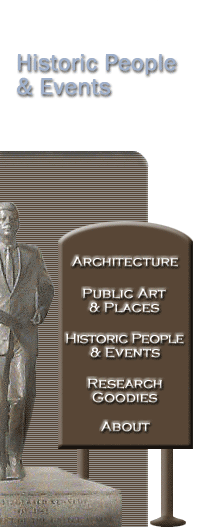|

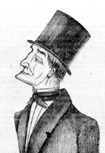 Dr. George Parkman
lived as a member of Boston's Brahmin elite. Having inherited substantial
wealth, he donated the land for the Harvard Medical School which was where
Massachusetts General Hospital on Storrow Drive stands today. Dr. George Parkman
lived as a member of Boston's Brahmin elite. Having inherited substantial
wealth, he donated the land for the Harvard Medical School which was where
Massachusetts General Hospital on Storrow Drive stands today.
He also made a loan to John Webster, a fellow society member and professor
at the medical college. Webster pledged all his property to Parkman as
collateral. When Dr. Parkman learned the professor had used his mineral
collection as collateral for other loans, he was furious and hounded him
for repayment.
On the evening of November 23rd, 1849, Dr. Parkman disappeared and was
not seen again. Over the next week Boston Police searched for Parkman
and followed several false leads. Rewards were offered.
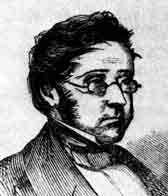 Unlike
Dr. Parkman who had inherited substantial wealth from which he lived,
Professor Webster lived from pay check to pay check. Keeping up appearances
was critical in Boston's Brahmin culture, and with two debutante daughters
he could no longer make ends meet. The police would eventually question
Webster, but were inclined to believe that respected members of society
wouldn't kill each other over money. Unlike
Dr. Parkman who had inherited substantial wealth from which he lived,
Professor Webster lived from pay check to pay check. Keeping up appearances
was critical in Boston's Brahmin culture, and with two debutante daughters
he could no longer make ends meet. The police would eventually question
Webster, but were inclined to believe that respected members of society
wouldn't kill each other over money.
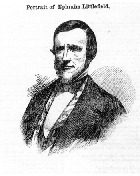 The
case was unexpectedly cracked by a Harvard janitor. Ephram Littlefield
lived adjacent to Webster's lab and had heard them argue. When the normally
stingy Webster gave him money to buy his family a Thanksgiving turkey,
Littlefield began to suspect Webster had something to hide. The
case was unexpectedly cracked by a Harvard janitor. Ephram Littlefield
lived adjacent to Webster's lab and had heard them argue. When the normally
stingy Webster gave him money to buy his family a Thanksgiving turkey,
Littlefield began to suspect Webster had something to hide.
As Webster's turkey cooked, Littlefield went next door and searched through
Webster's laboratory. So certain was he of Webster's guilt, that he broke
down a brick wall in Webster's medical school office to discover hidden
bones and a pair of dentures. Littlefield collected a substantial reward
for his efforts.
Webster was tried before the Supreme Judicial Court of Massachusetts and
was prosecuted by its Attorney General. The trial lasted twelve days;
and returned a guilty verdict, based entirely on circumstantial evidence.
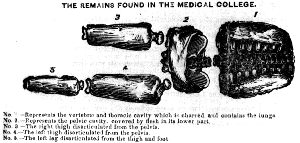 The jury
agreed that Webster, a chemist and MD, had killed Parkman in the Harvard
Medical and used its facilities to dismember and hide the body. Though
the bones couldn't be tied back to Parkman, the dentures fitted to his
distinctive forward jaw were. Webster made a late confession in an failed
attempt to avoid hanging. The jury
agreed that Webster, a chemist and MD, had killed Parkman in the Harvard
Medical and used its facilities to dismember and hide the body. Though
the bones couldn't be tied back to Parkman, the dentures fitted to his
distinctive forward jaw were. Webster made a late confession in an failed
attempt to avoid hanging.
Yet, how could janitor Littlefield have been so certain of Webster's culpability?
Testimony would show that he first charged Webster with the murder five
days before the body was found, before even Parkman's family believed
him to be dead. As Littlefield lived within feet of the bones, the circumstantial
evidence implicated him as much as Webster. And though Webster owed Parkman
a debt, Littlefield had been caught and disciplined for gambling in Parkman's
quarters, and profited directly from his conviction.
Perhaps the only bright spot in this story is that the feelings of animosity
between Webster and Parkman apparently not extend to their families. Parkman's
widow, remarkably, would later raise funds to help support Webster's wife
and children.
|
